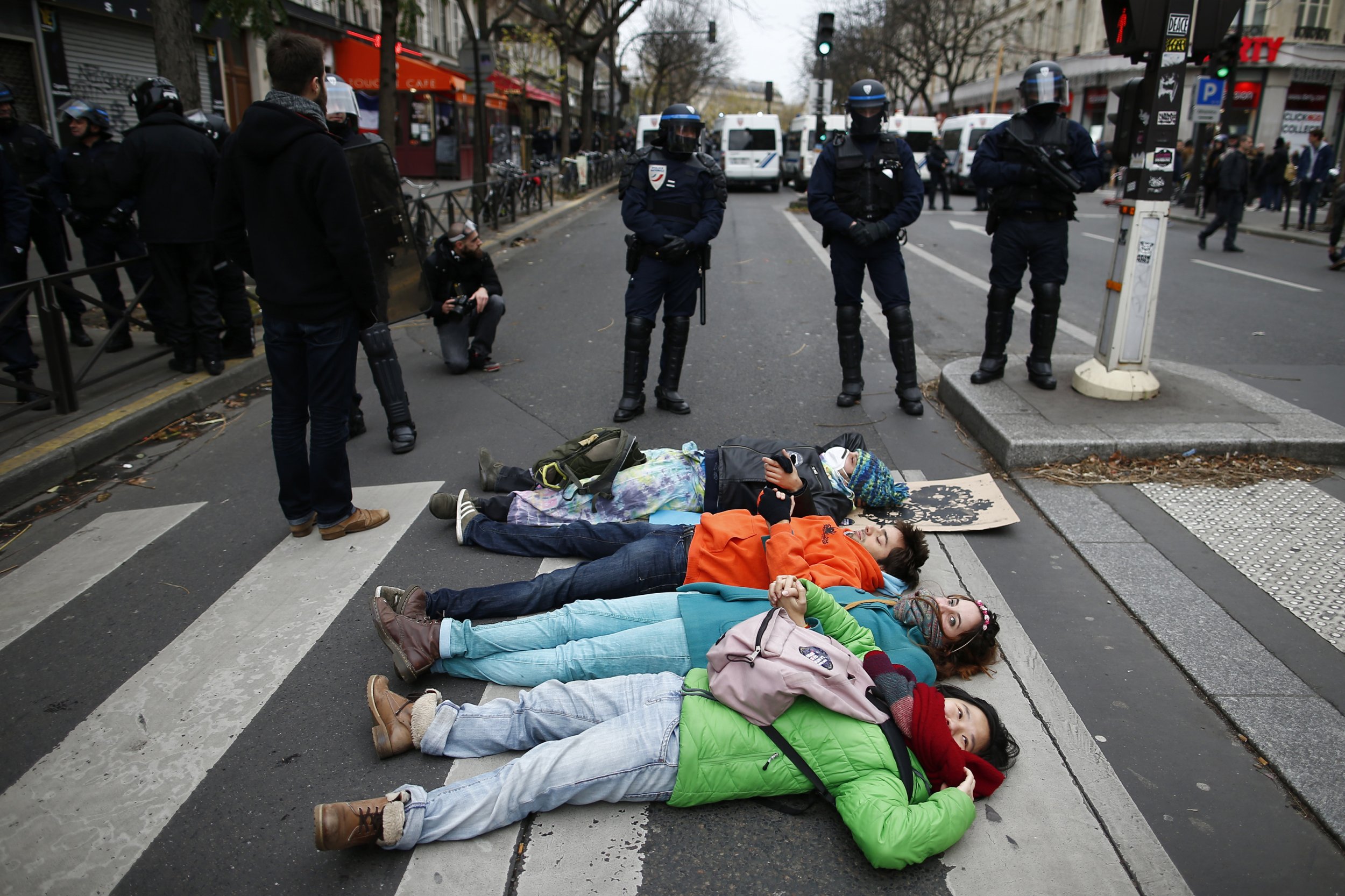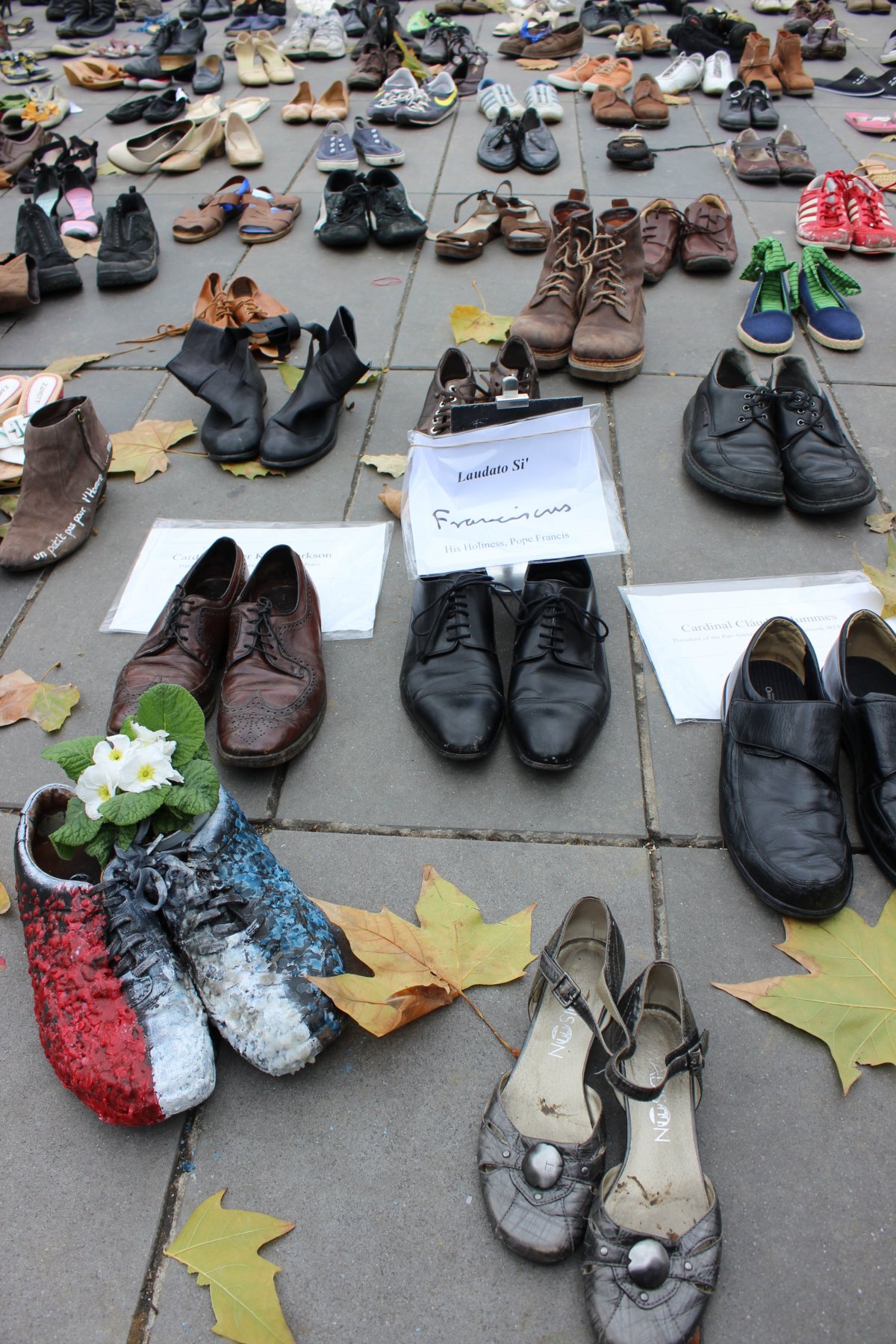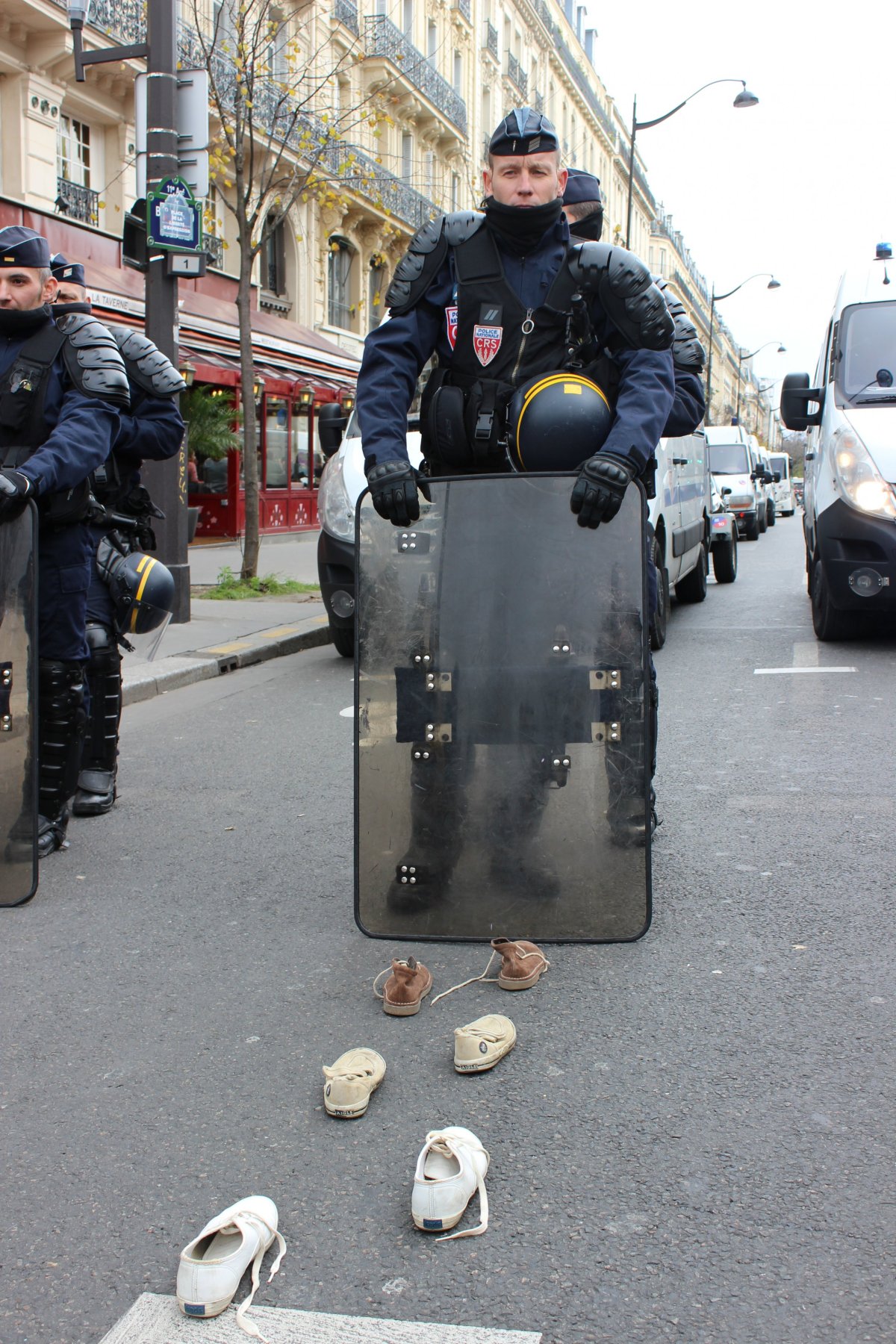
Amelie Cornu's sister-in-law was at the Bataclan theater on November 13, the night 130 people were killed in a series of coordinated attacks across Paris, and the site of the deadliest violence that night. She survived, although other friends of Cornu's friends did not. Iain Keith was sitting in a restaurant when he looked up to see a man outside of the window dressed all in black carrying a gun walking up the street and shouting. A waiter hurried Keith and the others there down the stairs and to a back room. All left physically unharmed. A friend of Alix's (who did not give a last name) lost her sister in the attacks.
"We all knew someone, or know someone who knew someone," directly harmed in the attacks," says Lola Sigogneau of the French climate organization Alternatiba. "But the same is true for all of Paris."
All were originally united by over a year's worth of effort to plan what they hoped would be the single largest march demanding action on climate in history, but their lives became inextricably linked that night by the worst attack in French history since World War II. The tragedy ultimately permeated every event held for the climate on November 29, the day before world leaders gathered in Paris for the United Nations 21st Conference of the Parties (COP21).
The French government declared a state of emergency following the attacks, which included a ban on public marches and demonstrations. In response, climate organizers launched "March4me.org" to encourage people to join in marches where they live in place of those who could not do so in Paris or in other cities recently struck by militants, including Beirut and Bamako, Mali.
As a result, instead of the estimated 500,000 persons that organizers hoped would fill the streets of Paris on November 29, 720,000 took part in climate action events in 175 countries, "making this the biggest climate mobilization in history," says Ria Voorhaar of the coalition group Climate Action Network.
But the ban on protest also fueled clashes with riot-gear-clad police in Paris, including by those accusing the government of using the November 13 attacks as an excuse to clamp down on their rights. They marched in the streets despite the ban, chanting "Liberté!" and "Police everywhere, justice nowhere."
The Pope's Shoes
Under gray skies and drizzle, 22,000 shoes sat empty in the Place de la République before the famed statue of Marianne symbolizing the core elements of the French Revolution: liberty, equality and fraternity. The plaza sits on the edge of the 11th Arrondissement, the Paris neighborhood where most of the attacks occurred. The statue, which has become an impromptu memorial for those killed and injured, is covered with candles, flowers, photographs of the dead and messages from loved ones.
Empty shoes are traditionally used to symbolize death during war, standing in honor of a fallen soldier or civilian casualty. Here, they stood in place of those who were unable to march in Paris but still wanted their presence to be felt.
Marie-Pierre Delaigue came from the suburbs of Paris to place a pair of brown shoes for a friend, having already contributed her own to the installation. Slim with white hair and aged skin, Delaigue looked pained to be at the site. "I already came here to pray for the dead, for the people who were injured," she says. "It's very sad, but it is also very important that we are here today. There are many places to cry, but now we have no choice—we must come here to stand up for the planet."
Delaigue's shoes joined those worn by women, men, children and toddlers, gathered over the past week and a half. Most were signed, some decorated, and many included personal messages. A pair of pink satin slippers with bows, darkened with use, was inscribed with the words Arretons de boire du petrole, or "End our addiction to oil," and was signed "Sylvain et Kelly."
Two slightly scuffed black leather dress shoes sat unobtrusively among all the others. They are the shoes of Pope Francis, hand-delivered that morning by a friend of his, Brazilian Cardinal Cláudio Hummes, along with a pair of the cardinal's own shoes and those of Ban Ki-moon, the U.N. secretary-general.

Dressed in a white clerical collar and a winter coat against the cold, the cardinal smiled good-naturedly as he answered questions within a scrum of reporters. Later he expressed the importance of the action to the pope, who, he said, hoped to inspire world leaders to "have the political will necessary to create a strong climate deal to prevail over this crisis." The day before, the cardinal cited the pope's June encyclical and an October appeal by Catholic bishops in calling for "drastic cuts of carbon emissions to keep the global temperature rise below the dangerous threshold of 1.5 degrees C" and the need to "put an end to the fossil fuel era and set a goal for complete decarbonization by 2050."
Emma Ruby-Sachs, acting executive director of the nonprofit advocacy organization Avaaz.org, which had organized the event and had many staff members, including Keith and Cornu, who were directly affected by the attacks, explained that the installation was both a "message that Parisians are determined to be heard on climate" and a memorial to the voices that were silenced because of the Paris attacks. "Terrorism tries to divide us, to pit us against each other," she argued. "But this climate conference and this climate movement are an opportunity for the world to cooperate together, to have wisdom as a collective group and actually save us, save our entire future."
As the shoes were laid in the square, thousands of people were lining up side by side, holding hands to form a nearly two-mile-long human chain stretching along Boulevard Voltaire, under a banner that read, "A State of Climate Emergency for a Climate of Peace." The official ban was on people marching in groups, and thus, organizers guessed, would not apply to people in a single-file line standing still on the sidewalk. The police largely agreed.
French families with small children stood side by side with environmental activists from California, Kentucky, Mississippi, North Dakota, New York and Texas, while Michelle Bachelet, the president of Chile, stood in the street across the way, speaking to reporters. They joined indigenous leaders from the Ecuadorian Amazon, Canada and Alaska, all of whom would have led the planned mass march, joining many others in representing those on the front lines of fossil fuel consumption's most harmful effects. Instead, they stood in small groups, far from the notice of many journalists, their numbers diminished by those fearful of traveling to Paris, bringing family members with them or joining in a non-permitted event.
Among those who made the trek was 18-year-old Esau Sinnok of the village of Shishmaref, which is perched on the edge of the Alaskan Arctic. Sinnok estimates that the village has about 25 years remaining before it will disappear into the ocean, "a victim of climate change." Though he believes that it is too late to save his home, he hopes that by being in Paris he will raise enough awareness of the need to keep fossil fuels in the ground in order to keep other communities from succumbing to a similar fate.
The Boom of Concussion Grenades
The protests were organized by the Coalition Climate 21, which represents 130 different advocacy groups. All 130 had agreed to adhere strictly to a nonviolence pledge. However, as the organized part of the protests dissolved, a smattering of violence did break out.
When the human chain unlinked, the 10,000 people present walked up Voltaire to la République, passing quietly by the series of makeshift memorials that had sprung up along the boulevard on corners and at parks. Several stopped and cried. Keith describes the 11th Arrondissement as the "New York East Village of Paris," an area where artists, musicians and students—and many activists—reside.
As they neared the plaza, several small groups broke off from the others and began testing the restrictions. A group of cyclists took over a lane of traffic with bikes; in another intersection, a musician played an accordion while activists tangoed, blocking traffic.
Others laid out pairs of shoes in a line, as if walking out of la République, across the street and toward Voltaire. The line of shoes stopped at the feet of riot police who had started to form lines around the plaza.

At one point, several hundred people in the plaza marched en masse down the street, where they confronted a line of riot police who, with little warning, started spraying heavy amounts of pepper spray. A much smaller group of perhaps 20 young men wearing matching black coats occasionally hurled large rocks at the officers, and later in the day several of the shoes were also thrown at police. Reports later emerged that bottles were thrown, as well as candles from the memorial. Police retaliation worsened; concussion grenades and a great deal more tear gas followed, as officers moved into the plaza, eventually detaining nearly 200 people.
The smattering of violence likely will not deter climate activists from further action this week. Charlotte Krede's children spent the weeks leading up to November 29 making art for the protests. She brought them to the events on that day and will bring them to many others as events continue throughout the two weeks of COP21.
Krede said not showing up would lead her to feel powerless. Her fear for her children is "from a world in which the alternatives to fossil fuels are not utilized, a world in which we do not take action on climate." Her anger is directed at those who fail to embrace the bravery and unity needed to combat climate change and instead succumb to violence and fear.
Antonia Juhasz is the author of several books, including most recently Black Tide: The Devastating Impact of the Gulf Oil Spill. Reach her at @AntoniaJuhasz.
Uncommon Knowledge
Newsweek is committed to challenging conventional wisdom and finding connections in the search for common ground.
Newsweek is committed to challenging conventional wisdom and finding connections in the search for common ground.
About the writer
To read how Newsweek uses AI as a newsroom tool, Click here.








